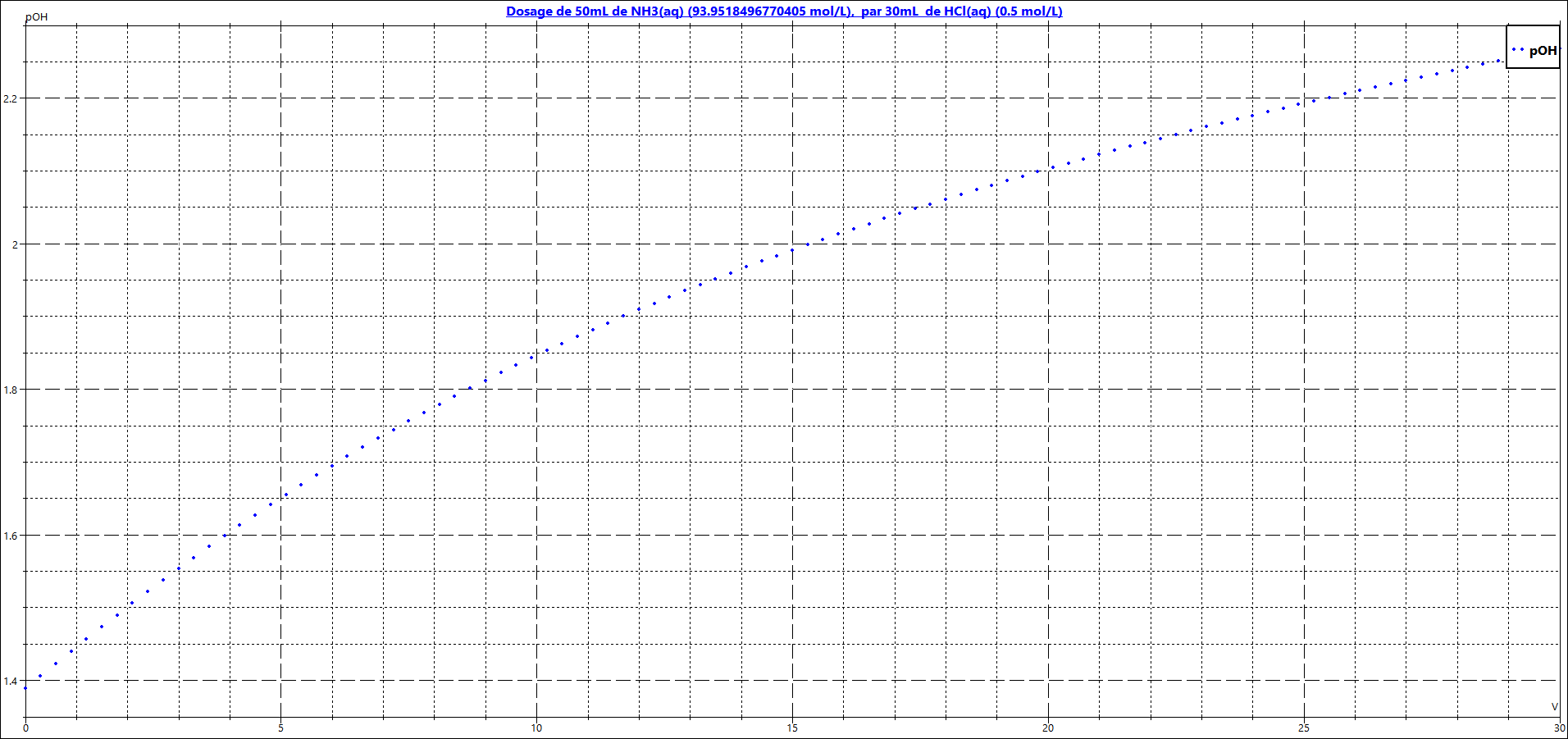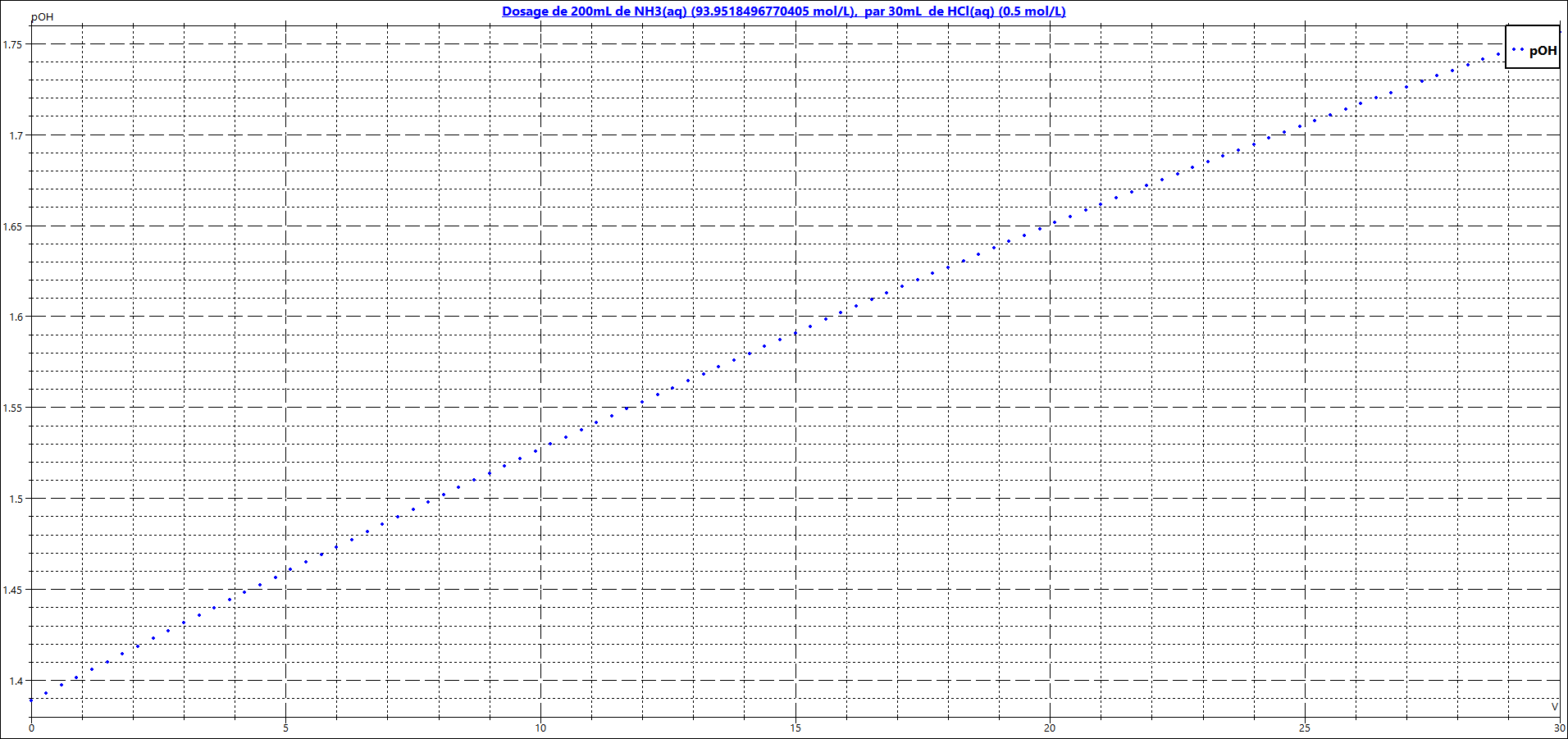I am first going to do the ‘flip side’ of the OP’s scenario and then basically flip it back. So we start with a $\pu{0.1 M}$ aqueous solution of benzoic acid and the initial solution volume is $\pu{25 mL}$. Benzoic acid is a monoprotic weak acid with $\mathrm{p}K_\mathrm{a} = 4.20$. The initial $\mathrm{pH}$ is $2.606$. The strong base used for the titration is $\pu{0.1 M} \ \ce{NaOH}$. At the equivalence point, the $\mathrm{pH = 8.454}$ and the solution volume is $\pu{50 mL}$ ($=\pu{25 mL}$ benzoic acid solution $+ \pu{25 mL} \ \ce{NaOH}$ solution). Thus, the $\mathrm{pH}$ is simply the $\mathrm{pH}$ of $\pu{0.05 M}$ sodium benzoate solution. After all $\pu{50 mL}$ of $\ce{NaOH}$ has been added, the $\mathrm{pH} = 12.523$ and the final solution volume is $\pu{75 mL}$. At the half-equivalence point, $\pu{12.5 mL}$ of $\ce{NaOH}$ has been added and $\mathrm{pH}= 4.185$.
Now assume the initial benzoic acid solution is only $\pu{0.025 M}$, but the initial volume is $\pu{100 mL}$. The total number of moles of benzoic acid is the same as before. The initial $\mathrm{pH}$ is $2.912$: the benzoic acid solution is only 25% as concentrated. At the equivalence point, the $\mathrm{pH} = 8.254$ and the solution volume is $\pu{125 mL}$ ($=\pu{100 mL}$ benzoic acid solution $+ \pu{25 mL} \ \ce{NaOH}$ solution). The equivalence point $\mathrm{pH}$ is closer to $\mathrm{pH}=7$ because the solution is simply a $\pu{0.02 M}$ sodium benzoate solution, i.e., the number of moles of sodium benzoate is now in a volume that is 2.5 times larger, so the concentration is 40% of $\pu{0.05 M}$. After all $\pu{50 mL}$ of $\ce{NaOH}$ has been added, the $\mathrm{pH}= 12.222$ and the final solution volume is $\pu{150 mL}$. At the half-equivalence point, $\pu{12.5 mL}$ of $\ce{NaOH}$ has been added and $\mathrm{pH} = 4.188$, moving slightly up toward $\mathrm{pH}=7$. See the titration curves below:

Now flipping back: the OP’s scenario involving a weak base titrated with strong acid. For reasons that will become clear, assume the hypothetical weak base has $\mathrm{p}K_\mathrm{b} = 9.80$, and that the strong acid is $\pu{0.1 M} \ \ce{HCl}$ solution. Note that the $\mathrm{p}K_\mathrm{b}$ is simply $14$ (treated as exact throughout) $- 4.20$.
As before, start by assuming $\pu{25 mL}$ of $\pu{0.1 M}$ weak base. The initial $\mathrm{pH} = 14 – 2.606 = 11.394$. At the equivalence point, the $\mathrm{pH} = 5.546$ and the solution volume is $\pu{50 mL}$ ($=\pu{25 mL}$ weak base solution $+ \pu{25 mL} \ \ce{HCl}$ solution). Thus, the $\mathrm{pH}$ is simply the $\mathrm{pH}$ of a $\pu{0.05 M}$ weak base salt solution. After all $\pu{50 mL}$ of $\ce{HCl}$ has been added, the $\mathrm{pH} = 1.477$ and the final solution volume is $\pu{75 mL}$. At the half-equivalence point, $\pu{12.5 mL}$ of $\ce{HCl}$ has been added and $\mathrm{pH} = 9.815$.
Now assume the initial weak base solution is only $\pu{0.025 M}$, but the initial volume is $\pu{100 mL}$. The total number of moles of weak base is the same as before. The initial $\mathrm{pH}$ is $11.088$: the weak base solution is only 25% as concentrated. At the equivalence point, the $\mathrm{pH} = 5.746$ and the solution volume is $\pu{125 mL}$ ($=\pu{100 mL}$ weak base solution $+ \pu{25 mL} \ \ce{HCl}$ solution). The equivalence point $\mathrm{pH}$ is closer to $\mathrm{pH}= 7$ because the solution is simply $\pu{0.02 M}$ weak base salt solution, i.e., the number of moles of weak base salt is now in a volume that is 2.5 times larger, so the concentration is 40% of $\pu{0.05 M}$. After all $\pu{50 mL}$ of HCl has been added, the $\mathrm{pH} = 1.778$ and the final solution volume is $\pu{150 mL}$. At the half-equivalence point, $\pu{12.5 mL}$ of $\ce{HCl}$ has been added and $\mathrm{pH} = 9.812$, moving slightly down toward $\mathrm{pH}= 7$. For the titration curves, simply imagine vertically flipping the titration curves, in the figure above, about a horizontal line at $\mathrm{pH} = 7$. Or just look at the plot:

One last thing: The $\mathrm{pH}$ values at half-equivalences were close to the respective $\mathrm{p}K$ values, as expected, but any buffer can be broken by dumping it into swimming pool full of water. So dilution may matter a great deal, or relatively little, depending on the specifics.




